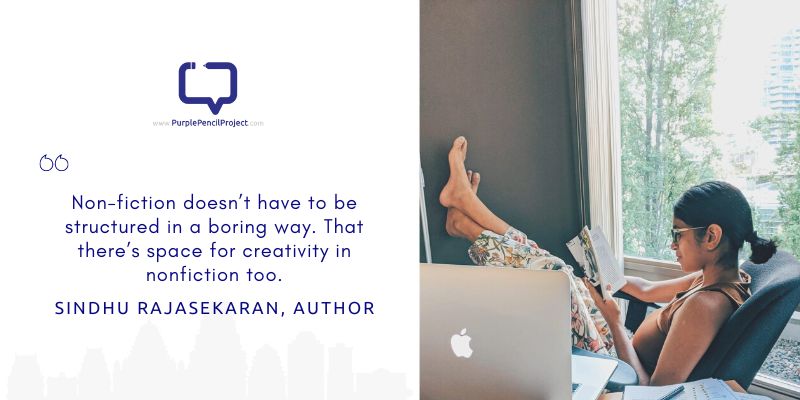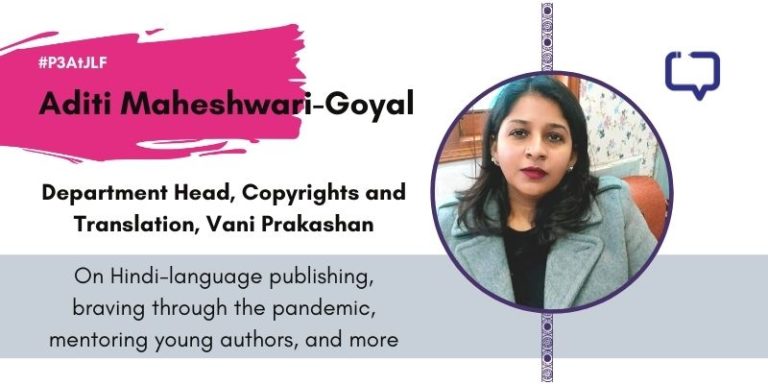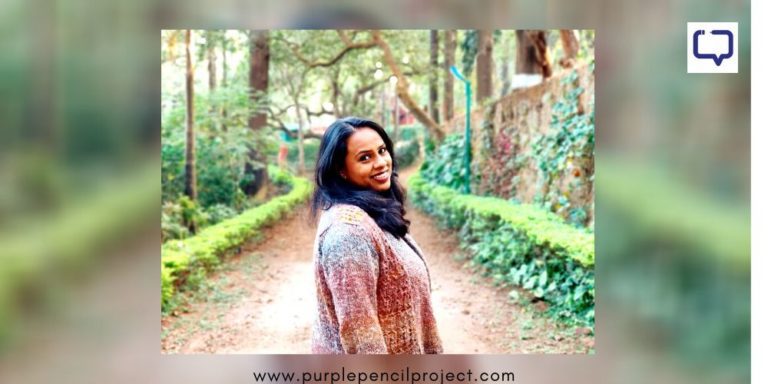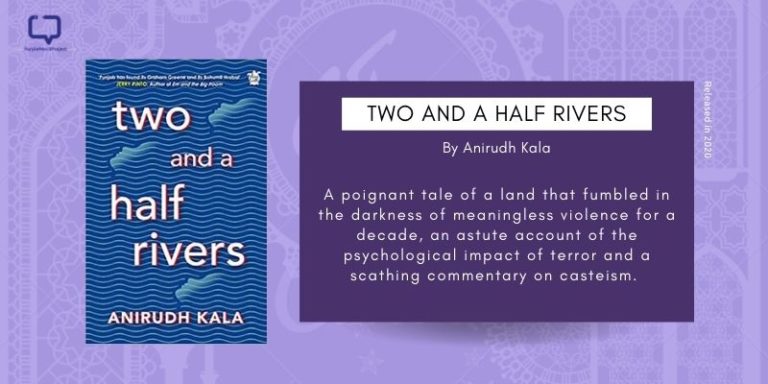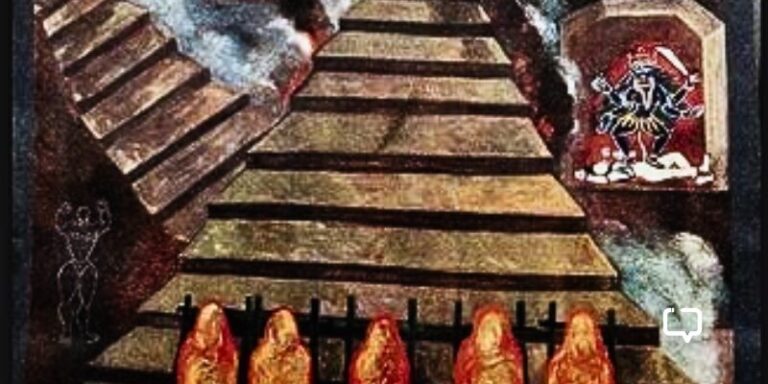Prakruti Maniar interviews Sindhu Rajasekaran, author of Smashing The Patriarchy: A Guide for the 21-st Century Indian Woman. Excerpts from an email interview.
We encourage you to buy books from a local bookstore. If that is not possible, please use the links on the page and support us. Thank you.
What has your own journey been with storytelling, while growing up. What are the books and movies that have influenced you? Are there feminist stories you read that left their mark?
Sindhu Rajasekaran: Reading has been quintessential to my existence. Growing up, I read widely and indiscriminately. Every other book seemed to pique my curiosity. Dickens, Austen, Brönte, Rushdie and Dosteovsky were early favourites. I also read a lot of history, commentary and philosophy (some of which I didn’t understand but read anyway).
Later I discovered Woolf. Being queer, I was very dysphoric in my adolescence. Only in my late teenage years did I start to think of myself as a woman, and started to read women’s narratives with a perceptive eye. It drew me in, and I started to question the POVs of male writers who I previously adored. Some of the earliest feminist works I read was probably Lessing and Le. Guin. To be honest, I didn’t really look for “feminist” books to read. I read women. Roy, Didion, Desai, Bama, etc. Feminist women existed in almost all narratives I read it seemed – women challenged the patriarchy in every other book, irrespective of whether it was projected as feminist or not. I became interested in feminist theory much later in life. Probably in my mid-twenties.
As regards movies, I watched a lot of international indie stuff. I liked poetic films, slow and rambling. That said, I also watched a lot of mainstream Hollywood and Kollywood growing up, critiquing and making mental notes of all that I found problematic with it.
In Smashing the Patriarchy, you write about the various feminisms of India – what has your personal introduction with feminism been? How has it changed with the geographies you lived in? Can it be bracketed within definition? With what angle did you come to writing the book? How did you keep any personal ideas of feminism aside to objectively speak of the contradictions in understanding feminism in India, right now?
Sindhu Rajasekaran: That’s a very interesting question. I think the longform answer to that is in the book. As a millennial who grew up freewheeling on the internet, and having moved between several cities and three countries, I’ve come to my understanding of feminism in a very subjective way. Geographies definitely change how you think about something. With regards to feminism, this has meant meeting different women with various ideologies (in my case).
What has constantly amazed me is how women, irrespective of their cultural or ideological backgrounds, constantly resist the patriarchy ~ how they subvert power relations. This has inspired me tremendously. As a feminist (in theory and praxis), I think my aim has been to move beyond victimhood and write about women as powerhouses, as survivors, as changemakers. To me, it is about telling women’s stories to inspire. To think beyond convention, to spotlight the complexities of being a woman, the contradictions, the joy, the struggles, and try to tell a nuanced story of contemporary feminist resistence in India.
Feminism, as I argue in the book, has no “one” definition. That’s something I believed in even as I started writing the book, but over the four years that I wrote it, I realised how women’s modes of resistance are diverse and subjective ad infinitum. I constantly had to unlearn and relearn my own understanding of feminism as I spoke with various women. But of course, everything I’ve written in the book is from my own subjective point of view.
Literally everything outside quotation marks (where I quote others) is my own subjectivity. There’s no running away from that poststructural, postmodern, postfeminist reality. Objectivity is a highly questionable proposition. I encourage readers to read my book in that way too. To remember that we are all individuals at the end of the day and nobody can speak for everybody. No matter how lofty or righteous our vision, at the end of the day we can all only speak for ourselves. Everything is subjective. So be critical of everything.
Click to read the full review of Smashing the Patriarchy
What was the research process for the book like? Because of the topic, it lends itself to being cancelled or called out very quickly, or I want to say, lends itself to intense scrutiny at least. Were you conscious of this when writing it? Was it part of the editorial discussions? Are there criticisms you have since its release?
Sindhu Rajasekaran: The research process spanned four years. I was simultaneously writing, interviewing and researching at that time. I tried to include as many diverse voices and perspectives as possible. I read widely and intertwined several discourses into my own. Still, I always knew that in a country as vast as India, that task is gargantuan. I think I did the best I could in my given timeframe. But there’s also more I wish I could have included – maybe in my next project, I tell myself.
About the potentially intense scrutiny, yes, that was part of editorial discussions and I knew the risks of writing a book like this. But honestly, I had nothing to hide. I’ve tried to be as open as I can with regards to my positionality and my personal stake in writing this book. On the other hand, I believe in productive debate and engagement with criticism. I’m not afraid of criticism – it has always helped me grow. And for feminism, debate is quintessential. That said, I do not engage with hate. If someone comes at me personally with the intent to discredit, I do not see the point in engaging with them. Because there’s no space for positivity or growth there.
Since the book has come out, I have engaged in various productive conversations surrounding it. I’ve also addressed criticisms wherever appropriate. I’m happy to do so in the future too.
How did you pick the areas you were going to focus writing about – like beauty, sex, queerness? Did you have to leave something out? Were there chapters that you wish you could include?
Sindhu Rajasekaran: I broadly picked those topics in consensus with my editors, but the subjects discussed within each were informed by my interactions with women I interviewed and my research. With every passing month, I’d add something new. News cycles inspired new ideas. Women I met brought new perspectives. In fact, I literally added paragraphs and footnotes to the book till it went into print.
Did I leave something out? Yes, tons of stuff. I had to stop adding things at some point. The book had to get done. But the hope was that the conversation will continue, questions will be asked, and I’d move on to my next project with all this in mind. Various things that came up during the process of writing this book are now part of my PhD research. So I suppose one thing leads to another.
Click to read an exclusive excerpt from Smashing the Patriarchy
As a writer of poetry, fiction, and non-fiction, screenwriting and even plays if I am not wrong, how do you approach the craft of each of these forms? Does it get difficult to switch between them? How does each borrow from the other? How much has a formal creative writing course helped in the process? What is the form you enjoy writing the most?
Sindhu Rajasekaran: Ultimately, I’ve come to think of myself as a storyteller. I don’t go into a narrative thinking it will be a novel, short story or nonfiction anymore. I start writing the story that’s on my mind, in an experimental way, and the form slowly reveals itself. In the beginning, I struggled with this ambiguity. But over the years, I’ve learned to enjoy the process. The joy of figuring out the right form to tell a particular story, or sometimes, an idea, or a character. It’s truly rewarding to spend time with the idea and see it transform into poetry or flash fiction, a monologue or a play, or a book of some form.
Feminism, as I argue in the book, has no “one” definition.
In my twenties, I largely dwelt on writing fiction and poetry, only when I turned thirty did I discover the beauty in nonfiction. I figured that nonfiction doesn’t have to be structured in a boring way. That there’s space for creativity in nonfiction too. That revelation led me to start writing creative nonfiction, essays, a book, and also in my academic writing – I strive to make the structure as creative as possible. To write something decolonial, queer or feminist, I’ve realized, is to question “forms” themselves and create something new. Something subjective, something that reflects everything that has made you who you are.
My master’s in creative writing definitely helped in opening up my mind. I was averse to writing short pieces when I went into the program. At that time, I thought I wanted to be a novelist. But my mentors encouraged me to experiment with different forms of writing. I wrote my first short story as part of that program – which went on to be published in the Asia Literary Review. That gave me confidence about my own capabilities – that I could write in many different ways.
What is my favourite form? Well, I’m still figuring that out. As of now, it’s in an experimental space where fiction and fact mingle, question one another, where logic and emotion merge, where new epistemologies slumber… There’s a lot of pleasure in looking for a form that reflects the processes of one’s mind. I haven’t found it yet. Hopefully in the near future I will.
Can you recommend films and books for those looking to start understanding feminism at a critical level? Perhaps material that was part of your research too?
Sindhu Rajasekaran: So, the books I recommend – remember that I don’t agree with all their contents a hundred percent. I’m recommending them because they will inspire questions, critiques, and encourage the reader to engage with various feminist issues.
- A Room of One’s Own by Virginia Woolf
- The Second Sex by Simone De Beauvior (Read this in its Marathi Translation too)
- Seeing Like A Feminist by Niveditha Menon
- Mannequin by Manjima Bhattacharya
- Borderlands/La Frontera: The New Mestiza by Gloria Anzaldúa
- Gender Trouble by Judith Butler
- ‘The Laugh of the Medusa‘, an essay by Hélène Cixous. Read it for free on JSTOR.
- Womanwriting = Manreading? By J. Devika
I’m not sure what movies to recommend exactly, because I’ve found feminist heroines in all sorts of films! The women who are typecast as arrogant, self-centred, rebellious, vamps, sluts, bitches – have all stood out as (post)feminist heroines to me. So I’d say learn to view films through a “female gaze” and you’d see feminists everywhere!

As part of our effort to compensate our writers better, we at Purple Pencil Project have launched the #PayTheWriter initiative, where readers can directly show support and appreciation for our wonderful team.
Scan or upload this image on your UPI app, and show them the love 😀








